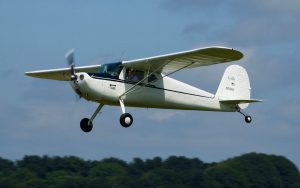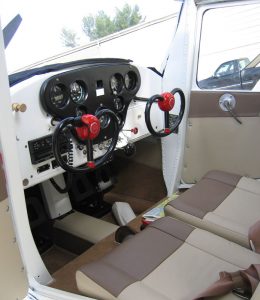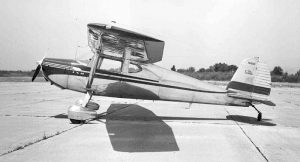Cessna 120, Cessna’s First Post-War Trainer, Has Stood the Test of Time as an Affordable Classic
The Cessna 140 was introduced in 1946, preparing to fill the need of the anticipated post-war boom of the aviation industry.4 Unfortunately, people weren’t rushing to buy airplanes like the manufacturers of the day thought they would. That didn’t stop Cessna from cranking out nearly 8,000 airframes in five year however, and the Cessna 120/140 would become the first evolution of the most popular trainer of all time, the Cessna 150.3
A month after the release of the Cessna 140, the Cessna 120 was introduced as an “economy” version and only remained in production for three years. Though they had the same engine, an 85 horsepower Continental, the Cessna 120 had no wing flaps, and the rear-cabin windows and electrical system (lights, battery, radios, starter) were optional.3 Though most Cessna 120’s putt-putting around the sky today are nearly indistinguishable from the 140, because of a plethora of post-factory options and owner-installed modifications, the Cessna 120 retains a classic charm and economic efficiency worth experiencing.
General Characteristics of the Cessna 120

Rick Durden of AvWeb says, “Cessna made the 120 about as simple as airplanes get, with side-by-side seating, yokes rather than sticks, no flaps and no rear window… Standard equipment did not include an electrical system, although a generator was available as an option. The International Cessna 120/140 Association tells us that none left the factory with one, however, most 120s have an electrical system these days.”7
The Cessna 120 was a two-seat conventional landing gear light utility airplane with cantilever wings, supported by two wing struts on each side. The monocoque fuselage and most elements were aluminum, as well as the wing ribs, but the 120 had fabric-covered wings. It’s conventional landing gear featured Cessna’s top-of-the-line (at the time) spring steel main gear, and a steerable Scott tailwheel.3
| Length | 21 ft |
| Height | 6.5 ft |
| Empty Weight | 770 lbs |
| Max Gross Weight | 1,450 lbs |
| Fuel Capacity | 25 gal |
Dimensions and characteristics from Skytamer.1
Performance Specifications
The Cessna 120 was powered by an 85 horsepower Continental C-85-12 four-cylinder air-cooled engine, and was pulled by a Sensenich two-blade wooden fixed-pitch propeller.3
| Fuel Burn (cruise) | 5-7 gph |
| Range | 450 miles |
| Service Ceiling | 15,500 ft |
| Cruise Speed | 85-100 kts |
| Max Speed | 122 kts |
| Takeoff Roll | 650 ft |
| Takeoff Roll Over 50ft Obstacle | 1,850 ft |
| Landing Roll | 460 ft |
| Landing Roll Over 50ft Obstacle | 1,530 ft |
| Climb Rate | 640 fpm |
| Useful Load | 665 lbs |
Performance specs from Rising Up Aviation.2
Cessna 120: Handling
Budd Davisson of Air Bum4 reports, “Unless converted to key start, the airplane has a separate pull-to-start handle which, to a pilot used to modern Spam cans, seems unusual. Once the engine is running, the straight exhausts are evident even at idle. On takeoff they really bark. It’s hard to believe we all used to fly these without headsets, as a matter of course. No wonder we’re all half-deaf. If the tailwheel is in even remotely good shape, the airplane will taxi nearly as effortlessly as a nosewheel airplane, needing an occasional tap on the brakes to make sharp corners. The excellent visibility makes it that much easier.”
Start Up, Taxi, and Takeoff
On a flight with Melanie “Mel” Willies, a pilot who raced with the Royal Aero Club, Keith Wilson, an aerospace photojournalist reports that, “The engine crackles into life at a steady idle and I check as the oil pressure rises. ‘If it doesn’t rise within 30 seconds, shut it down,’ is the instruction from [Mel]. We sit patiently until the oil temperature indicator moves off the bottom of the gauge. When it does, I gently ease on a little power with the stick held back and check the brakes. They are very effective—something I’ll need to watch later on landing. This aircraft has toe brakes fitted on both sides, making it an excellent tailwheel trainer. I taxi to the holding point, S-turning all the way. Visibility is fine to the left of the cowling but S-turning confirms the way ahead is clear.”9
“If the tailwheel is in even remotely good shape, the airplane will taxi nearly as effortlessly as a nosewheel airplane, needing an occasional tap on the brakes to make sharp corners. The excellent visibility makes it that much easier.” Budd Davisson
He goes on to describe the simplicity of the airplane (since it has no flaps or electric backup fuel pump, etc.) and how responsive it is to rudder input. Keith reports that they took off at around 40 mph after about a 650 foot takeoff roll.9
Maneuvering and Cruise

According to Mark Zakula, a Cessna 120 owner interviewed by AVweb, “The aircraft has a fairly low wing loading, so it doesn’t handle the bumps very well. If it gets too bumpy, I just slow down a bit and it seems to ride a little better. The rudder is large and sensitive. This is an advantage in crosswind landings, but takes a little practice and a light touch to keep from yawing around in flight. Adverse yaw is pretty strong.”7
A common thread I’ve noticed throughout my research is that many pilots agree that the rudder is ultra sensitive and the light airplane can easily be pushed around by the wind, more so at high speeds. However, Keith of Cessna Flyers9 goes on to say that it handles incredibly well in slow flight as well as at racing speeds. Mel demonstrated a few racing turns for him, and he was surprised at how sharp and fast they were.
Landing
“There are no flaps, so speed is important,” Mel tells Keith before landing. “And don’t forget the carb heat. Continentals generally—but especially the C-90s—are prone to carb icing.”
Keith reports that on final descent, the pilot remains occupied by constant control inputs, especially rudder, to keep the airplane tracking the center line. On his grass-field landing, Keith said that he didn’t need to use brakes because the airplane slowed “very nicely” without them. Rick Durden said that the docile airplane doesn’t even need flaps, explaining why so many 120 owners never made the “upgrade.” “Any pilot worthy pf the title should be able to put one of these into a pea patch without need for flaps.”7
Variants of the Cessna 120
Cessna 140
Like the Cessna 120, the Cessna 140 was equipped with an 85 horsepower Continental engine, but came stock with the electrical systems and wing flaps. However, most The Cessna 140 was originally equipped with an 85 or 90 horsepower (63 or 67 kW) Continental horizontally-opposed, air cooled, four-cylinder piston engine. This model has a metal fuselage and fabric wings with metal control surfaces.3
Cessna 140A
In 1949, Cessna retired the Cessna 120 and introduced the Cessna 140A. In addition to upgrading the engine to a 90 HP Continental, the 140A also came standard with “metalized” (aluminum covered) wings,
eliminating the expensive need to get the wings re-covered every decade or so. The 140A also condensed the dual V-struts on the wings with one strut, and moved the spring-steel gear 3 inches forward, which lowered the chances of the forward-heavy airplane of nosing over when pilots slammed on the brakes.3
Modifications and Upgrades

The most popular upgrades to the Cessna 120 mainly have to do with structural repairs and preventative measures, such as metalizing the wings or getting them coated in fiberglass. Though metalizing eliminates the need for regular replacement of wing fabric (which can be very expensive), some pilots believe it’s worth the trouble, and recommend getting the fabric replaced with more modern fabrics and coatings instead of metal.10
In addition to replacing the older equipment and instruments (replacing the brake system is important), there is also an autogas STC available for the Cessna 120.7
Some pilots would prefer to add an engine with more horsepower, but because of the limited fuel supply, just a bit more power can dramatically chop into your flight time. Also, landing gear extenders are popular, but some pilots say unnecessary, to prevent nose-overs.3
Weak Spots by Rick Durden7
-
Look for damage in the lower door posts, near the strut attach point. This critical structural member may be damaged by rough field operation, ground loops or corrosion.
-
Corrosion in the carry-through spar can be a problem. The cabin skylight leaks water into this structure, and years of moisture will take a toll.
-
Cracks in the tail structure and rear fuselage. Those familiar with the 120/140 tell us the airplane’s tail is the weakest part of the design. It’s especially vulnerable around the tailwheel attach point. This is repairable, but make it a condition of the sale during pre-buy.
-
Landing-gear boxes take a beating on all Cessnas and the 120/140 is no exception. The gear box—the support structure for attaching the landing gear to the fuselage—may have taken abuse from pilots over the years, thanks to hard landings and maybe even a ground loop or two. The box can be inspected from the outside by removing an inspection plate in the cabin floor.
-
Broken tailsprings are fairly common. Check to ensure that the steel leaf-type tailwheel spring is still springy but not saggy. A broken spring will cause complete loss of control on landing and could do major damage to the airplane, particularly the elevators. Even if the springs look good at the time of purchase, they should be inspected regularly.
Operating and Purchase Costs
1946, Cessna 120: $2,695 Cessna 140: $3,495
2017, Cessna 120: $15,000-$28,500 Cessna 140: $15,000-$33,000
Tailwheel aircraft are notoriously more expensive to insure, but if you have tailwheel experience, you can probably expect to pay around $1,000/yr, or $1,500/yr with no tailwheel experience (I called AOPA and got a quote for $1,547 for a low-time pilot with no tailwheel experience). Burning only 5 gallons an hour definitely has its perks, though with the tiny fuel supply, your range is just as limited. Luckily, most of the Cessna 120’s for sale today have been treated well and hangared, and there are plentiful parts for repairs, so maintenance costs should be minimal.
Final Thoughts on the Cessna 120
The Cessna 120 is a supremely affordable airplane to buy and operate, but its mission is fairly limited. It doesn’t have a lot of range or power, but it’d be a great trainer, and a ton of fun to fly if you work in the next town over, or take short weekend trips with a friend. It’s been described as docile and diminutive, but I think those words understate how enjoyable it can be to fly. For those who prefer tailwheels, the light and sporty Cessna 120 is an even better trainer than the Cessna 150.
Featured image taken by Bill Larkin, used under license CC 2.0
Resources and References
- Cessna 120, Skytamer. Retrieved 4/7/17
- Cessna 120 Performance Data, Rising Up Aviation. Retrieved 4/7/17
- Cessna 140, Wikipedia. Retrieved 4/7/17
- “Stacking Cessna’s Littlest Against Other Classics,” Budd Davisson, Air Bum. Retrieved 4/7/17
- Cessna 120/140, AOPA. Retrieved 4/7/17
- “Cessna’s 120: A Delightful Little Bird,” Ben Sclair, General Aviation News. Retrieved 4/7/17
- Cessna 120/140 Review, Rick Durden, AvWeb. Retrieved 4/11/17
- Cessna 120/140 1946-1948, Plane & Pilot Magazine. Retrieved 4/7/17
- “Cessna 120: Mel’s Little Marvel,” Keith Wilson, Cessna Flyer Association. Retrieved 4/11/17
- ’48 Metalized Wing Owners/Operators, “Gahorn,” The International Cessna 170 Association. Retrieved 4/11/17


